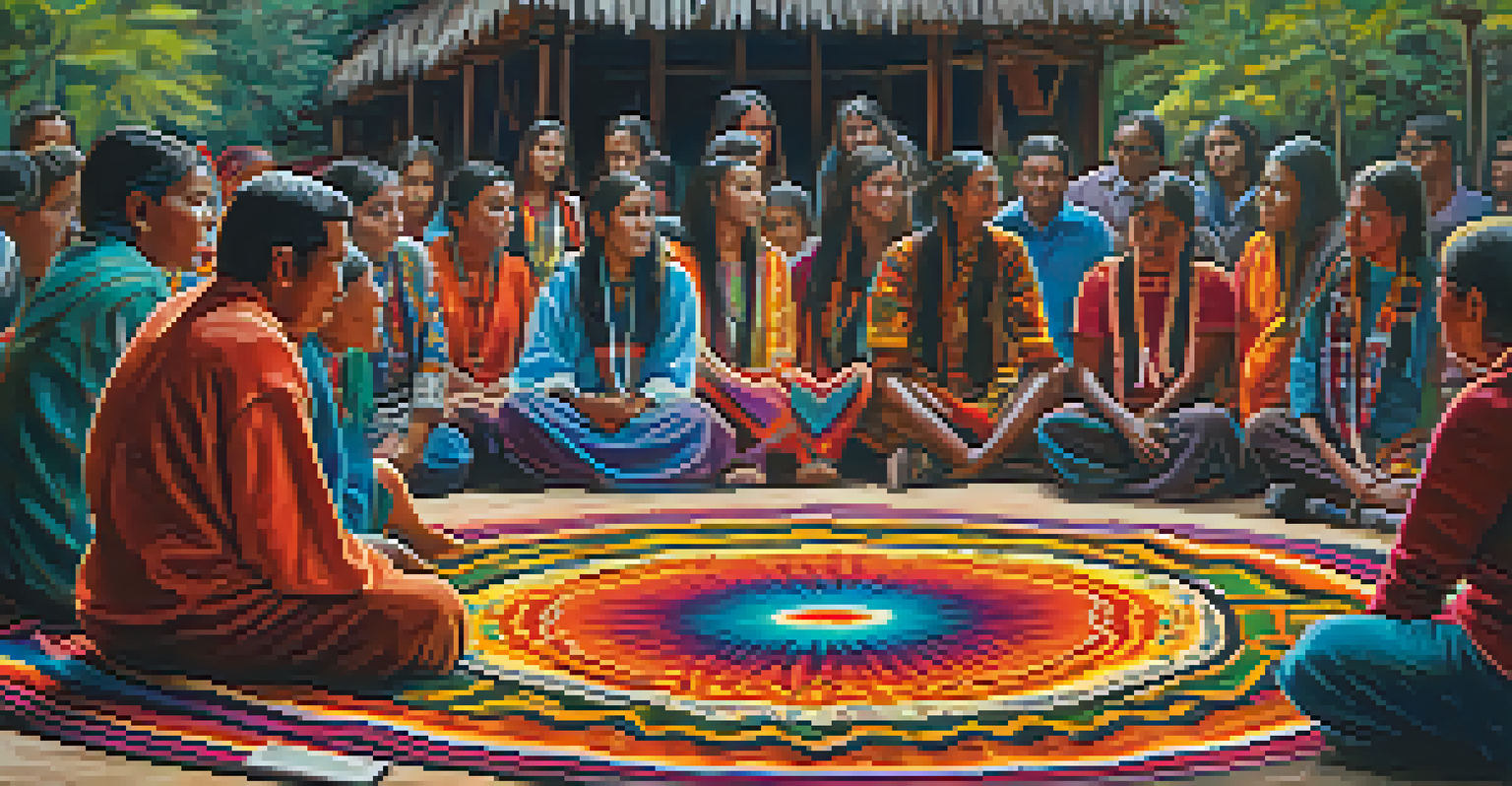Understanding Personal Responsibility in Ayahuasca Experiences

What is Ayahuasca and Its Purpose?
Ayahuasca is a powerful plant medicine traditionally used by indigenous tribes in the Amazon rainforest. It is typically brewed from the Banisteriopsis caapi vine and other plants, creating a brew known for its psychedelic properties. People often seek Ayahuasca for healing, spiritual growth, and profound self-discovery, leading them to confront their innermost thoughts and emotions.
The journey is the destination.
While many enter an Ayahuasca ceremony seeking guidance or answers, it's essential to understand that this journey doesn’t absolve them of responsibility. Participants must be prepared to engage actively with their experiences, taking ownership of what arises during the ceremony. This understanding sets the stage for a transformative experience, one that requires both openness and accountability.
Ultimately, Ayahuasca serves as a mirror, reflecting back the personal challenges and issues we carry. Recognizing this, individuals are encouraged to approach their journeys with a mindset of responsibility, fostering growth and insight that can extend beyond the ceremony itself.
The Role of Personal Responsibility in Healing
Personal responsibility is a cornerstone of healing, especially in the context of Ayahuasca experiences. When participants accept that they are the architects of their healing journey, they empower themselves to confront past traumas and patterns. This mindset not only enhances the therapeutic potential of the experience but also promotes lasting change in their lives.

For example, someone might experience intense emotions during a ceremony, such as fear or sadness. Recognizing these feelings as part of their healing process allows them to dive deeper into understanding why these emotions surfaced. By taking responsibility for their reactions, they can work through the emotions and gain valuable insights, rather than simply avoiding or suppressing them.
Personal Responsibility in Healing
Embracing personal responsibility empowers individuals to confront their emotions and patterns, enhancing the therapeutic potential of their Ayahuasca experience.
Moreover, embracing personal responsibility fosters a sense of agency. It encourages participants to actively engage with the lessons learned during the ceremony, integrating those insights into their daily lives. This proactive approach can lead to significant personal transformations and healthier coping mechanisms.
Setting Intentions Before the Ceremony
Setting intentions is a vital practice before participating in an Ayahuasca ceremony. By clarifying what they hope to achieve—be it healing, clarity, or connection—participants create a roadmap for their journey. This preparatory step is an expression of personal responsibility, as it shows a commitment to engage earnestly with the experience.
We do not learn from experience... we learn from reflecting on experience.
For instance, someone might set an intention to explore their relationship with fear, wanting to understand its roots and how it affects their life. This intention acts as a guiding star during the ceremony, helping them navigate the emotional landscape that unfolds. When challenges arise, having a clear intention can provide focus and direction, making the experience more meaningful.
Additionally, sharing intentions with the group or facilitator can foster a sense of community and support. It reminds participants that they are not alone in their journeys and that each person's experience is uniquely valuable. This collective energy can amplify the healing potential of the ceremony.
Navigating Difficult Experiences Responsibly
Difficult experiences, often referred to as 'bad trips,' can be daunting during an Ayahuasca ceremony. However, understanding that these challenges are part of the healing process is crucial. Personal responsibility means recognizing that these experiences can lead to significant insights if approached with an open mind.
For instance, someone might confront painful memories or feelings of anxiety during their journey. Instead of resisting these emotions, they can choose to lean into the discomfort, understanding that processing these feelings is a step toward healing. This active participation is essential in transforming a potentially overwhelming experience into an opportunity for growth.
Setting Intentions for Clarity
Establishing clear intentions before the ceremony provides a roadmap for the journey, helping participants navigate their emotional landscapes.
Moreover, having a supportive facilitator or group can help individuals navigate these challenging moments. It’s important to communicate feelings openly, reinforcing the idea that vulnerability is a strength. By taking responsibility for their reactions and seeking support, participants can emerge from difficult experiences with newfound clarity and resilience.
Integrating Insights After the Ceremony
The journey doesn’t end when the Ayahuasca ceremony concludes; in fact, integration is one of the most critical aspects of the experience. Personal responsibility plays a key role here, as individuals must actively work to incorporate the insights gained into their everyday lives. This process can solidify the lessons learned and ensure lasting change.
For example, someone who realized their tendency to self-sabotage during the ceremony may choose to reflect on this behavior in their daily routine. By journaling, seeking therapy, or discussing their experiences with trusted friends, they create a supportive framework for lasting change. This proactive approach is a testament to their commitment to personal growth.
Additionally, joining integration circles or support groups can provide a space for sharing experiences and strategies. These communities foster accountability, reminding participants that they are not alone in their journeys. By taking responsibility for their integration, individuals can transform their Ayahuasca experiences into lifelong tools for self-improvement.
The Importance of Self-Reflection
Self-reflection is a powerful tool that complements the Ayahuasca experience. Engaging in this process allows individuals to critically assess their thoughts, feelings, and actions, promoting deeper understanding and growth. Personal responsibility is key here, as it encourages individuals to confront uncomfortable truths about themselves.
After a ceremony, someone might take time to reflect on their experience and identify recurring themes or emotions. This practice of introspection can lead to valuable insights, helping them recognize patterns in their lives that may need addressing. By taking responsibility for their reflections, they can cultivate a clearer understanding of their path forward.
Integrating Insights for Growth
The integration process after the ceremony is crucial, as it allows individuals to actively incorporate the insights gained into their daily lives for lasting change.
Furthermore, self-reflection can be enhanced through various practices, such as meditation, writing, or art. These activities provide an outlet for processing emotions and thoughts that have surfaced during the ceremony. Ultimately, this commitment to self-exploration reinforces the importance of personal responsibility in the Ayahuasca journey.
Creating a Supportive Environment
A supportive environment is crucial for anyone embarking on an Ayahuasca journey. This includes not only the physical space of the ceremony but also the emotional and social support surrounding the experience. Personal responsibility involves seeking out and cultivating this supportive atmosphere, which can significantly enhance the healing process.
For instance, individuals may choose to attend ceremonies led by experienced facilitators who prioritize safety and support. Surrounding themselves with like-minded individuals can also create a sense of community and belonging. This environment allows participants to share their experiences and feelings, fostering deeper connections and understanding.

Moreover, maintaining a supportive network after the ceremony is equally important. Friends and family who are understanding and open to discussing the journey can provide invaluable support during the integration phase. By taking responsibility for their environment, participants can create a nurturing space that encourages healing and growth.